Building of the Month - January 2016


The Crimean Monument, Ferrycarrig, County Wexford, photographed on the 4th March 2015 following its restoration in October-November 2014
The visitor now draws near to the bridge of Ferry Carrig, with its old guardian tower on the right, and the new and lofty circular fabric on the left – the sides of the precipices, on the parts of which they stand, in the full freshness of their verdant summer dress, appearing to the best possible advantage. The amateur or artist who may be disposed to employ his pencil in depicting the striking and varied beauties of this renowned locality will now find another highly-important adjunct, which, whether looked upon as an object suggestive of sympathy for the loss of the young and the brave, whose memory it has been erected to commemorate, and the recollection of whose gallant and heroic deeds it is so well calculated to perpetuate, or, as a faithful representation of the old pillar temples of the country, must, in a pictorial point of view, be considered of the most unquestionable advantage to those who delight in sketching scenes of natural and artificial beauty.
So begins Thomas Lacy’s description of the Crimean Monument, Ferrycarrig, County Wexford, shortly after its unveiling in 1858.
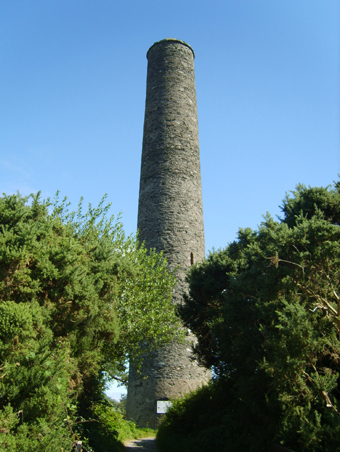
The Crimean Monument, Ferrycarrig, County Wexford, photographed on the 30th August 2007. The foundation stone of the monument, designed by Edwin Thomas Willis (1835-1905) of Rowe Street, Wexford, was laid in October 1857 and the completed monument was unveiled in 1858. The monument takes the form of an early Christian round tower and attests to the contemporary interest in native Irish architecture while marking a shift from the Classical language of earlier monuments including the Browne Clayton Column (1839-41) at the midway point between Wexford and New Ross. Thomas Lacy (1863) makes an interesting, and little acknowledged connection between the two war memorials when he mentions that ‘The Crimean Heroes’ monument bears testimony to the bravery of the house of Browne, as the only son of Mr. Browne Clayton JP DL, and the grandson of General Browne, was one of the many blooming members of our aristocracy who fell in that victorious but still disastrous campaign’ |
The round tower is an architectural form almost unique to Ireland. Approximately one hundred and twenty round towers are thought to have been built in Ireland between the ninth and twelfth centuries and, although most are now in ruins, about twenty survive in near-perfect condition. The towers range in height from fifty-nine feet to one hundred and thirty feet and the stone work varies according to the date of construction with early examples showing rough rubble stone and later examples showing neatly joined blocks. All of the surviving towers show a solid base with an elevated door opening overhead. In addition to defence, the elevated door opening assisted the structural integrity of the tower as, normally built with very little foundations, a door opening at ground level would weaken the tower. The structural integrity of the tower was also assisted by its round profile, being gale-resistant. Four slit windows, aligned with the cardinal points, light the upper levels while the “cap” or roof is usually conical in shape.
The purpose of the round tower has long been debated and speculation reached fever pitch in the early nineteenth century with theories including fire temples for sun worship and Druidic celestial observatories. Arguably the most outlandish theory was by Henry O’Brien (1808-35) who, in The Round Towers of Ireland, or the Mysteries of Freemasonry, of Sabaism, and of Buddhism (1834), suggested that the round towers were monuments to the fertility god Priapus introduced to Ireland in the pre-Christian period by Buddhists from India. The context of the round tower was firmly established by George Petrie LLD (1789-1866) in his essay Origins and Uses of the Round Towers of Ireland (1833), awarded a prize of £50 from the Royal Irish Academy, and his later book The Ecclesiastical Architecture of Ireland anterior to the Anglo-Norman Invasion Comprising an Essay on the Origin and Uses of the Round Towers (1845). Petrie concluded that the round towers were intended as belfries – the Irish word for round tower, cloigtheach, translating as bellhouse – and doubled as safe houses in which valuables, and even people, could take shelter in times of attack. The academic interest in the round tower coincided with, or perhaps motivated the restoration of a number of towers across Ireland including the lightning-struck Killala Round Tower, County Mayo, in 1841. The leaning Kilmacduagh Round Tower, County Galway, was restored in 1879 following its partial collapse in 1858. Elsewhere, the round tower was adopted as a symbol of Irish nationalism. A granite ashlar round tower (1851-5) in Prospect Cemetery, Glasnevin, designed by Patrick Byrne (1782/3-1864) and a contemporary of the Crimean Monument, was erected as a memorial to Daniel O’Connell (1775-1847). |
The Crimean War (October 1853-February 1856) claimed over 600,000 in a conflict in which Russia lost to an alliance of Britain, France, the Ottomnan Empire and Sardinia-Piedmont. Irish soldiers made up approximately one third of the British forces and it is estimated that almost 7,000 Irish soldiers were killed in the conflict. The conclusion of the war was celebrated in Ireland at the Great Crimean Banquet which took place in the Tobacco Stores, Dublin, on the 22nd October 1856. Soon thereafter monuments were erected across Ireland to remember those lost in the war.
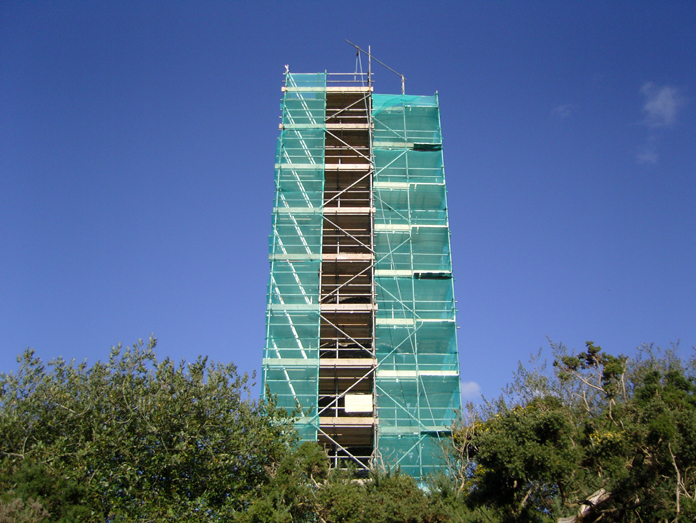
The Crimean Monument, Ferrycarrig, County Wexford, photographed on the 12th October 2014 with the scaffolding in place in preparation for its restoration
The design for the monument commemorating the men of Wexford lost ‘in the sanguined field of Ballaklava and Inkerman’ has been attributed to Edwin Thomas Willis (1835-1905) of Rowe Street, Wexford, and the foundation stone was laid on the 8th October 1857 by George William Frederick Howard (1802-64), seventh Earl of Carlisle and Lord Lieutenant of Ireland (fl. 1855-64). We are led to believe that a time capsule was buried in the base containing a copy of the newspaper of the day, a list of subscribers who donated £300 towards the cost of construction, and the parchment scroll used at its dedication. The round tower, while giving the false impression of early Christian origins, can claim an archaeological precedent by default as the stone work used in its construction was uprooted from the FitzStephen ringwork on the site. The completed monument was unveiled in July 1858.
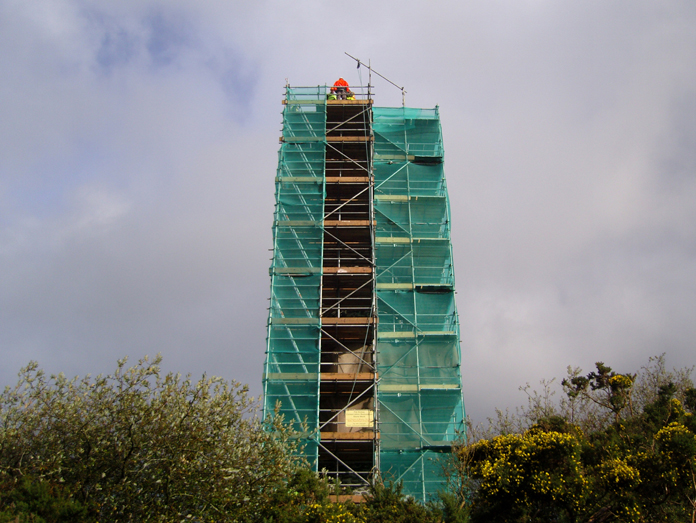
The Crimean Monument, Ferrycarrig, County Wexford, photographed on the 3rd November 2014 at the topping out ceremony attended by Ivor McIlveen Associates and officials from the Department of Arts, Heritage and the Gaeltacht and Wexford County Council
One hundred and fifty years of exposure eventually took its toll on the monument and, following the offer of a grant from the Department of Arts, Heritage and the Gaeltacht under the Conservation Works to Heritage Buildings in State Care Grant Scheme 2014, its restoration was undertaken by Ivor McIlveen Associates on behalf of Wexford County Council.
Initial inspections carried out in January 2013 and following Storm Darwin in February 2014 had highlighted the hazards presented by the tower which, due to storm damage and prolonged weathering, was under threat of partial or total collapse. A 3D laser scan survey confirmed that the “cap” had probably been struck by lightning, resulting in a hole visible from the inside of the tower, while further dislodged stone work presented the risk of falling masonry. In addition, a series of fissures, some rising to a height of nine feet, surrounded the base of the tower with the most prominent in line with the impact hole in the “cap”, giving further evidence of a lightning strike.
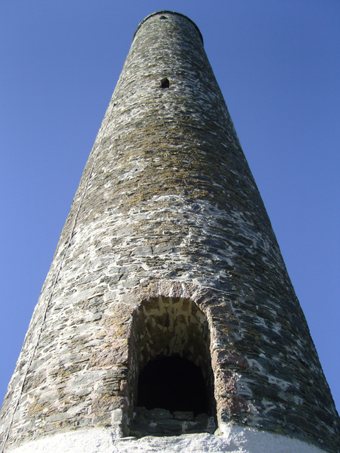
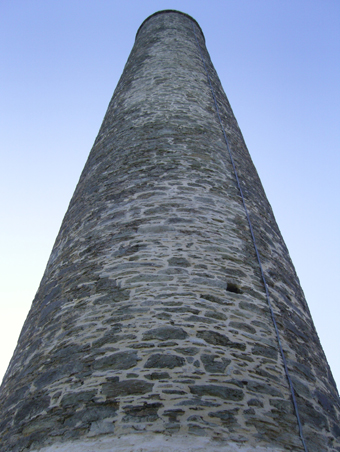
The Crimean Monument, Ferrycarrig, County Wexford, photographed on the 4th March 2015 showing the stone work repaired and repointed using a gauged hot-lime mortar which, in terms of aesthetics, is an excellent match in colour and has already begun to blend with the existing mortar
The round tower, a familiar landmark to anyone entering Wexford from the Dublin side, was temporarily hidden from view behind scaffolding in October 2014 in preparation for its restoration. A cross brace stitching system and deep grouting was used to repair the fissures around the base. Localised pocket masonry repairs were also required and, following general raking and repointing, the base was finished with a shelter-coat of limewash. Overhead, raking and hot-lime repointing of the stone work was carried out where necessary. The dislodged stones on the “cap” were carefully reset and a lightning conductor installed. The latter was almost tested during the topping out ceremony on the 3rd November 2014 when storm clouds loomed ominously overhead.
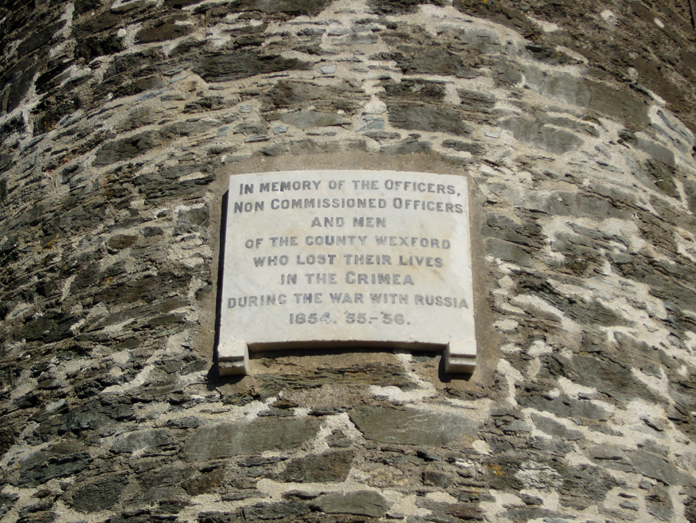
A panel is inscribed: IN MEMORY OF THE OFFICERS, NON COMMISSIONED OFFICERS AND MEN OF THE COUNTY WEXFORD WHO LOST THEIR LIVES IN THE CRIMEAN DURING THE WAR WITH RUSSIA 1854 ’55 ’56
The completed restoration ensures that the Crimean Monument, as Lacy predicted, ‘is likely to endure for the ages…and will serve to convey to posterity the unquestionable fact that the men of Wexford of the present day have not degenerated from the courage and bravery of their ancestors’.
The Crimean Monument is one of numerous sites across the country for which records have been prepared by the National Inventory of Architectural Heritage (NIAH) and the National Monuments Service (NMS). Both sets of records can now be accessed on the recently-deployed Historic Environment Viewer accessible here.
FURTHER READING
Lacy, Thomas, Sights and Scenes in Our Fatherland (London: 1863)
Back to Building of the Month Archive